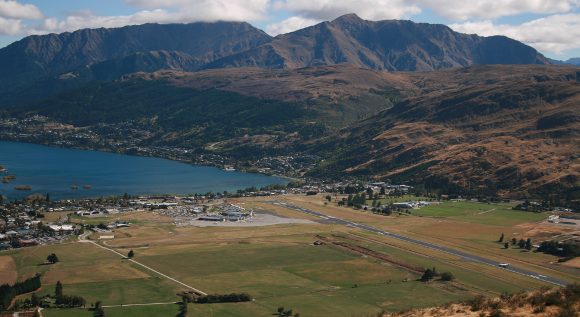Queenstown
All charts for Queenstown (NZQN) are available from the VATNZ Website.
Recommended add-on scenery for Queenstown is listed here.

Successfully operating an aircraft in or out of Queenstown is one of the most rewarding aviation experiences in this part of the world. Modern sims do a great job of replicating the challenges involved, and the following tips provide some pointers to ensure your Queenstown flights are as smooth as possible.
Become familiar with the approaches
None of the approaches at Queenstown are "straight-in". If you're flying into NZQN during the event, it's vital that you have some familiarity with the approaches. All charts for Queenstown are available at the VATNZ Website.
No over-size aircraft!
The approach to Queenstown requires tight maneuvering and excellent speed control. Real-world the largest airliners that fly into Queenstown are B737s and A321s. Every year thousands of virtual lives are lost as online pilots attempt to land larger aircraft: almost all of them fail, and it's strongly recommended that you leave the heavies for a larger airport.
Plan ahead: ** bring extra holding fuel **
The terrain surrounding Queenstown limits the number of aircraft that can be conducting approaches and departures at the same time. For this reason, you should plan for the possibility of a hold when arriving into Queenstown. Make sure you have sufficient fuel to remain in a hold, as well as to reach your alternate airport (probably NZCH).
NOTE: in a major event such as Cross the Ditch, declaring a fuel emergency will NOT get pilots priority arrival. Either carry extra fuel in anticipation of potential holds (the real-world solution), or use your simulator's systems to top up your tanks in-flight.
There is no ILS here: expect to be RNAV or visual by the time you land.
Queenstown relies heavily on RNAV arrivals to safely navigate the mountainous terrain that surrounds Queenstown on all sides. These feed directly into corresponding RNAV approaches that will guide you to the runway.
In practice not all simulator aircraft are equally capable of following the RNAV approaches to the threshold, so pilots should be prepared to complete a manual landing through the final stages of the approach if required.
Pilots who are unable to perform the RNAV procedures, should advise controllers and can expect vectors to the VOR/DME BRAVO and CHARLIE approaches. These direct you towards the Queenstown VOR, located on a hill a few miles northeast of the airport. Once you have the airport in sight, you conduct a visual approach to touchdown.
Note: the VOR/DME approaches increase controller workload and reduce the number of aircraft that can be passed through the Queenstown airspace, so pilots are strongly requested to fly the RNAV procedures if able.
RNAV Arrivals
Flights arriving in Queenstown from Cairns can expect to be assigned one of the following RNAV arrivals depending on the active runway:
- Runway 05:
UBDAM THREE ALFA LIBLA TRANSITION (LIBLA.UBDAM3A) → RNAV Y RWY 05 - Runway 23:
UBDAM FOUR BRAVO LIBLA TRANSITION (LIBLA.UBDAM4B) → RNAV Y RWY 23
RNAV Departures
Flights departing Queenstown for Avalon can expect to be assigned one of the following RNAV departures depending on the active runway:
- Runway 05: IPNOR THREE ALFA ADKOS TRANSITION (IPNOR3A.ADKOS).
- Runway 23: IPNOR THREE BRAVO ADKOS TRANSITION (IPNOR3B.ADKOS).
Pilots unable to fly the RNAV departures, should advise ATC and expect vectors to their filed route.
